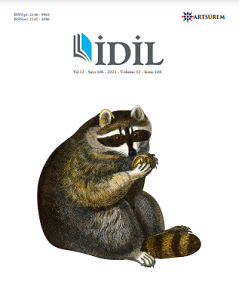KŪKAI’NİN MANDALA KONSEPTİ İLE MARK ROTHKO ŞAPELİ’NİN ANALOJİSİ
THE ANALOGY BETWEEN KŪKAI’S MANDALA CONCEPTION AND MARK ROTHKO’S CHAPEL
Author(s): Şevket Cem OnatSubject(s): Visual Arts, Aesthetics, Indian Philosophy, Sociology of Art
Published by: Sanat ve Dil Araştırmaları Enstitüsü
Keywords: Kūkai; Mark Rothko; Rothko Chapel; Buddhism; Mandala; Mysticism; Abstract Expressionism;
Summary/Abstract: The effects of mysticism in art have been researched throughout art history. In this context, the power of belief systems over art is revealed in an undeniable way. Either in 6th century or 20th century, the effects of religious teachings continue to have their reflections on art works. Kūkai and Mark Rothko will be studied within this perspective. Kūkai, known as Kōbō Daishi, lived in the last quarter of the 6th century and the first half of the 7th century. Kōbō means "widely spreading the teaching of Buddhism", daishi means "perfect teacher". Kūkai is the founder of the Shingon School and the monastery located on Mount Kōya, as well as the father of Ezoterik Buddhism. Kūkai's philosophy is based on merging dualist viewpoints such as rationality and metaphysics, abstract and concrete, simplicity and diversity. Kūkai's mandala approach can be grouped under four main headings: Mahā (Body), Samaya (Speech), Dharma (Mind), and Karma (Action). According to Kūkai, none of these four titles are independent from each other. When mandalas are defined as visual images used to concentrate on the center of the mind, the lack of even one of these four elements can be interpreted as the meditative effort provided by the mandala will be in vain. The purpose of use of mandalas is to achieve a spiritual maturity that can be communicated with the images created by the imagination by purifying from phenomena. This maturity is one of the most important experiences used to reach Buddha. In 1964, John and Dominique de Menil, collector and museum director commissioned Mark Rothko and architect Philip Johnson. Mark Rothko is one of the most important artists of the 20th century. Rothko and Johnson were built a chapel dedicated to spiritual ecumenicalism and human rights for St Thomas University in Houston, Texas, USA. However, the mentioned chapel was made independent on February 27, 1971, one year after Rothko's death, and became known as the Rothko Chapel. The octagonal architecture of Rothko Chapel creates a symmetrical plan reminiscent of a mandala. When standing in the center of the Chapel, which is a meditative space filled with Rothko's paintings, the audience can watch all the art works from an equal distance. The aim of this study is to evaluate both the visual and mystical structure of the Rothko Chapel with Kūkai's view of mandala and art approach within the context of art, philosophy, theology, architecture, etc. It is aimed to contribute to the enrichment of interdisciplinary approaches in the fields.
Journal: İdil Sanat ve Dil Dergisi
- Issue Year: 12/2023
- Issue No: 106
- Page Range: 738-749
- Page Count: 12
- Language: Turkish

